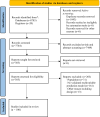Individualized prediction models in ADHD: a systematic review and meta-regression
- PMID: 38783054
- PMCID: PMC11609101
- DOI: 10.1038/s41380-024-02606-5
Individualized prediction models in ADHD: a systematic review and meta-regression
Abstract
There have been increasing efforts to develop prediction models supporting personalised detection, prediction, or treatment of ADHD. We overviewed the current status of prediction science in ADHD by: (1) systematically reviewing and appraising available prediction models; (2) quantitatively assessing factors impacting the performance of published models. We did a PRISMA/CHARMS/TRIPOD-compliant systematic review (PROSPERO: CRD42023387502), searching, until 20/12/2023, studies reporting internally and/or externally validated diagnostic/prognostic/treatment-response prediction models in ADHD. Using meta-regressions, we explored the impact of factors affecting the area under the curve (AUC) of the models. We assessed the study risk of bias with the Prediction Model Risk of Bias Assessment Tool (PROBAST). From 7764 identified records, 100 prediction models were included (88% diagnostic, 5% prognostic, and 7% treatment-response). Of these, 96% and 7% were internally and externally validated, respectively. None was implemented in clinical practice. Only 8% of the models were deemed at low risk of bias; 67% were considered at high risk of bias. Clinical, neuroimaging, and cognitive predictors were used in 35%, 31%, and 27% of the studies, respectively. The performance of ADHD prediction models was increased in those models including, compared to those models not including, clinical predictors (β = 6.54, p = 0.007). Type of validation, age range, type of model, number of predictors, study quality, and other type of predictors did not alter the AUC. Several prediction models have been developed to support the diagnosis of ADHD. However, efforts to predict outcomes or treatment response have been limited, and none of the available models is ready for implementation into clinical practice. The use of clinical predictors, which may be combined with other type of predictors, seems to improve the performance of the models. A new generation of research should address these gaps by conducting high quality, replicable, and externally validated models, followed by implementation research.
© 2024. The Author(s).
Conflict of interest statement
Competing interests: Dr. Salazar de Pablo has received honoraria from Janssen Cilag, Lundbeck and Angelini. Dr Archer is supported by funding from the NIHR Birmingham Biomedical Research Centre at the University Hospitals Birmingham NHS Foundation Trust and the University of Birmingham. Dr. Solmi has received honoraria/has been a consultant for Abbvie, Angelini, Lundbeck, Otsuka. Prof. Fusar-Poli has received grant support from Lundbeck and honoraria fees from Angelini, Menarini, and Lundbeck. In the past year, Dr. Faraone received income, potential income, travel expenses continuing education support and/or research support from Aardvark, Aardwolf, AIMH, Tris, Otsuka, Ironshore, KemPharm/Corium, Akili, Supernus, Atentiv, Noven, Sky Therapeutics, Axsome and Genomind. With his institution, he has US patent US20130217707 A1 for the use of sodium-hydrogen exchange inhibitors in the treatment of ADHD. He also receives royalties from books published by Guilford Press: Straight Talk about Your Child’s Mental Health, Oxford University Press: Schizophrenia: The Facts and Elsevier: ADHD: Non-Pharmacologic Interventions. He is Program Director of www.ADHDEvidence.org and www.ADHDinAdults.com . Prof Larsson reports receiving grants from Shire Pharmaceuticals; personal fees from and serving as a speaker for Medice, Shire/Takeda Pharmaceuticals and Evolan Pharma AB; all outside the submitted work. Henrik Larsson is editor-in-chief of JCPP Advances. Prof. Cortese has declared reimbursement for travel and accommodation expenses from the Association for Child and Adolescent Central Health (ACAMH) in relation to lectures delivered for ACAMH, the Canadian AADHD Alliance Resource, the British Association of Psychopharmacology, and from Healthcare Convention for educational activity on ADHD.
Figures



Similar articles
-
Implementing Precision Psychiatry: A Systematic Review of Individualized Prediction Models for Clinical Practice.Schizophr Bull. 2021 Mar 16;47(2):284-297. doi: 10.1093/schbul/sbaa120. Schizophr Bull. 2021. PMID: 32914178 Free PMC article.
-
Prognostic models for predicting clinical disease progression, worsening and activity in people with multiple sclerosis.Cochrane Database Syst Rev. 2023 Sep 8;9(9):CD013606. doi: 10.1002/14651858.CD013606.pub2. Cochrane Database Syst Rev. 2023. PMID: 37681561 Free PMC article. Review.
-
Prognostic models for newly-diagnosed chronic lymphocytic leukaemia in adults: a systematic review and meta-analysis.Cochrane Database Syst Rev. 2020 Jul 31;7(7):CD012022. doi: 10.1002/14651858.CD012022.pub2. Cochrane Database Syst Rev. 2020. PMID: 32735048 Free PMC article.
-
Multi-domain prognostic models used in middle-aged adults without known cognitive impairment for predicting subsequent dementia.Cochrane Database Syst Rev. 2023 Jun 2;6(6):CD014885. doi: 10.1002/14651858.CD014885.pub2. Cochrane Database Syst Rev. 2023. PMID: 37265424 Free PMC article. Review.
-
Predictive Models for Estimating the Probability of Successful Vaginal Birth After Cesarean Delivery: A Systematic Review.Obstet Gynecol. 2022 Nov 1;140(5):821-841. doi: 10.1097/AOG.0000000000004940. Epub 2022 Oct 5. Obstet Gynecol. 2022. PMID: 36201785
Cited by
-
Single-dose methylphenidate induces shift in functional connectivity associated with positive longer term clinical response in adult attention-deficit/hyperactivity disorder.Sci Rep. 2025 Feb 17;15(1):5794. doi: 10.1038/s41598-025-87204-3. Sci Rep. 2025. PMID: 39962109 Free PMC article.
-
Neural basis for individual differences in the attention-enhancing effects of methylphenidate.Proc Natl Acad Sci U S A. 2025 Apr;122(13):e2423785122. doi: 10.1073/pnas.2423785122. Epub 2025 Mar 24. Proc Natl Acad Sci U S A. 2025. PMID: 40127280 Free PMC article.
-
Commentary: Using QbTest for monitoring pharmacological treatment response in ADHD - are we there yet?J Child Psychol Psychiatry. 2025 Feb;66(2):266-270. doi: 10.1111/jcpp.14071. Epub 2024 Nov 8. J Child Psychol Psychiatry. 2025. PMID: 39513414 Free PMC article.
References
-
- American Psychiatric Association. Washington DC. Diagnostic and statistical manual of mental disorders. 2013.
-
- Cortese S. The neurobiology and genetics of Attention-Deficit/Hyperactivity Disorder (ADHD): What every clinician should know. Eur J Paediatr Neurol. 2012;16:422–33. - PubMed
-
- Cortese S. Pharmacologic treatment of attention deficit-hyperactivity disorder. N. Engl J Med. 2020;383:1050–6. - PubMed
Publication types
MeSH terms
LinkOut - more resources
Full Text Sources
Medical

